2008 CHRYSLER TOWN AND COUNTRY light
[x] Cancel search: lightPage 66 of 531
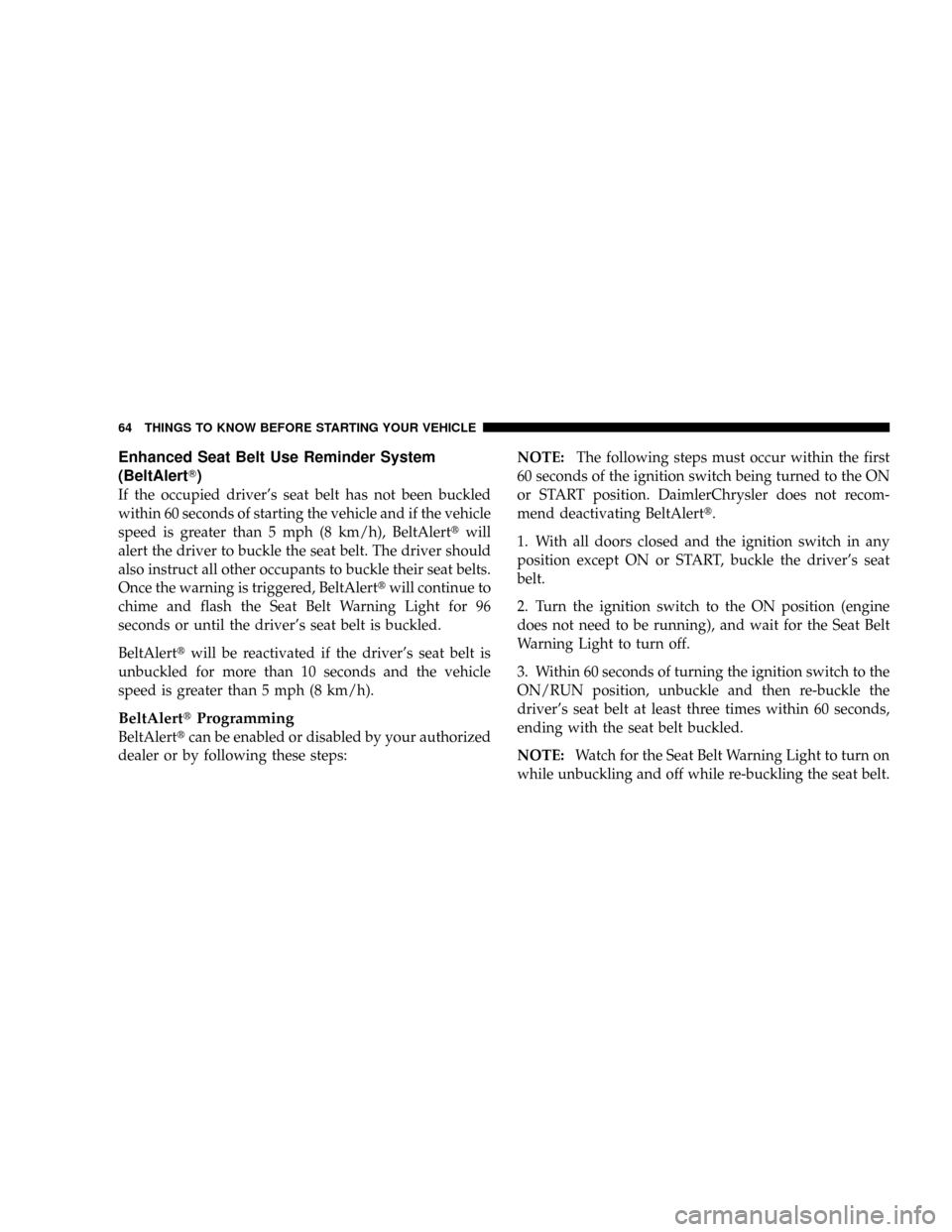
Enhanced Seat Belt Use Reminder System
(BeltAlertT)
If the occupied driver's seat belt has not been buckled
within 60 seconds of starting the vehicle and if the vehicle
speed is greater than 5 mph (8 km/h), BeltAlerttwill
alert the driver to buckle the seat belt. The driver should
also instruct all other occupants to buckle their seat belts.
Once the warning is triggered, BeltAlerttwill continue to
chime and flash the Seat Belt Warning Light for 96
seconds or until the driver's seat belt is buckled.
BeltAlerttwill be reactivated if the driver's seat belt is
unbuckled for more than 10 seconds and the vehicle
speed is greater than 5 mph (8 km/h).
BeltAlerttProgramming
BeltAlerttcan be enabled or disabled by your authorized
dealer or by following these steps:NOTE:The following steps must occur within the first
60 seconds of the ignition switch being turned to the ON
or START position. DaimlerChrysler does not recom-
mend deactivating BeltAlertt.
1. With all doors closed and the ignition switch in any
position except ON or START, buckle the driver's seat
belt.
2. Turn the ignition switch to the ON position (engine
does not need to be running), and wait for the Seat Belt
Warning Light to turn off.
3. Within 60 seconds of turning the ignition switch to the
ON/RUN position, unbuckle and then re-buckle the
driver's seat belt at least three times within 60 seconds,
ending with the seat belt buckled.
NOTE:Watch for the Seat Belt Warning Light to turn on
while unbuckling and off while re-buckling the seat belt.
64 THINGS TO KNOW BEFORE STARTING YOUR VEHICLE
Page 67 of 531
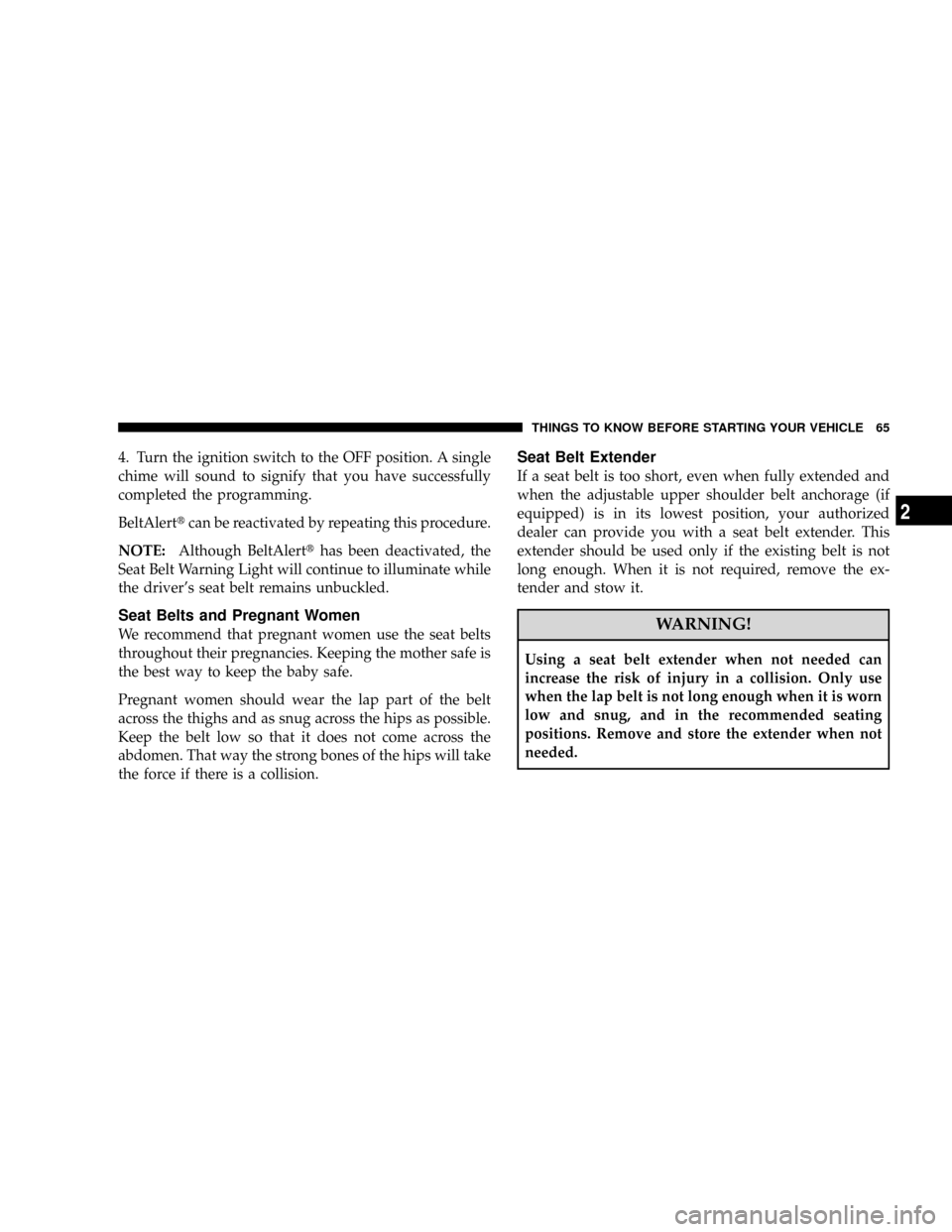
4. Turn the ignition switch to the OFF position. A single
chime will sound to signify that you have successfully
completed the programming.
BeltAlerttcan be reactivated by repeating this procedure.
NOTE:Although BeltAlertthas been deactivated, the
Seat Belt Warning Light will continue to illuminate while
the driver's seat belt remains unbuckled.
Seat Belts and Pregnant Women
We recommend that pregnant women use the seat belts
throughout their pregnancies. Keeping the mother safe is
the best way to keep the baby safe.
Pregnant women should wear the lap part of the belt
across the thighs and as snug across the hips as possible.
Keep the belt low so that it does not come across the
abdomen. That way the strong bones of the hips will take
the force if there is a collision.
Seat Belt Extender
If a seat belt is too short, even when fully extended and
when the adjustable upper shoulder belt anchorage (if
equipped) is in its lowest position, your authorized
dealer can provide you with a seat belt extender. This
extender should be used only if the existing belt is not
long enough. When it is not required, remove the ex-
tender and stow it.
WARNING!
Using a seat belt extender when not needed can
increase the risk of injury in a collision. Only use
when the lap belt is not long enough when it is worn
low and snug, and in the recommended seating
positions. Remove and store the extender when not
needed.
THINGS TO KNOW BEFORE STARTING YOUR VEHICLE 65
2
Page 68 of 531

Supplemental Restraint System (SRS) - Airbag
This vehicle has airbags for both the driver and front
passenger as a supplement to the seat belt restraint
systems. The driver's front airbag is mounted in the
center of the steering wheel. The passenger's front airbag
is mounted in the instrument panel, above the glove
compartment. The words SRS AIRBAG are embossed on
the airbag covers.
NOTE:The front airbags are certified to the Federal
regulations that allow less forceful deployment.
The front airbags have a multistage inflator design. This
may allow the airbag to have different rates of inflation
that are based on collision severity and occupant size.
This vehicle may also be equipped with Supplemental
Seat Side Airbag Inflatable Curtains (SABIC) to protect
the driver, front, and rear passengers sitting next to awindow. If the vehicle is equipped with SABIC air bags,
they are located above the side windows and their covers
are also labeled: SRS AIRBAG.
NOTE:Airbag covers may not be obvious in the interior
trim; but they will open to allow airbag deployment.
Airbag System Components
The airbag system consists of the following:
²Occupant Restraint Controller (ORC)
²Airbag Telltale Light
²Driver Airbag
²Front Passenger Airbag
²Front and Side Impact Sensors
²Steering Wheel and Column
²Instrument Panel
66 THINGS TO KNOW BEFORE STARTING YOUR VEHICLE
Page 69 of 531
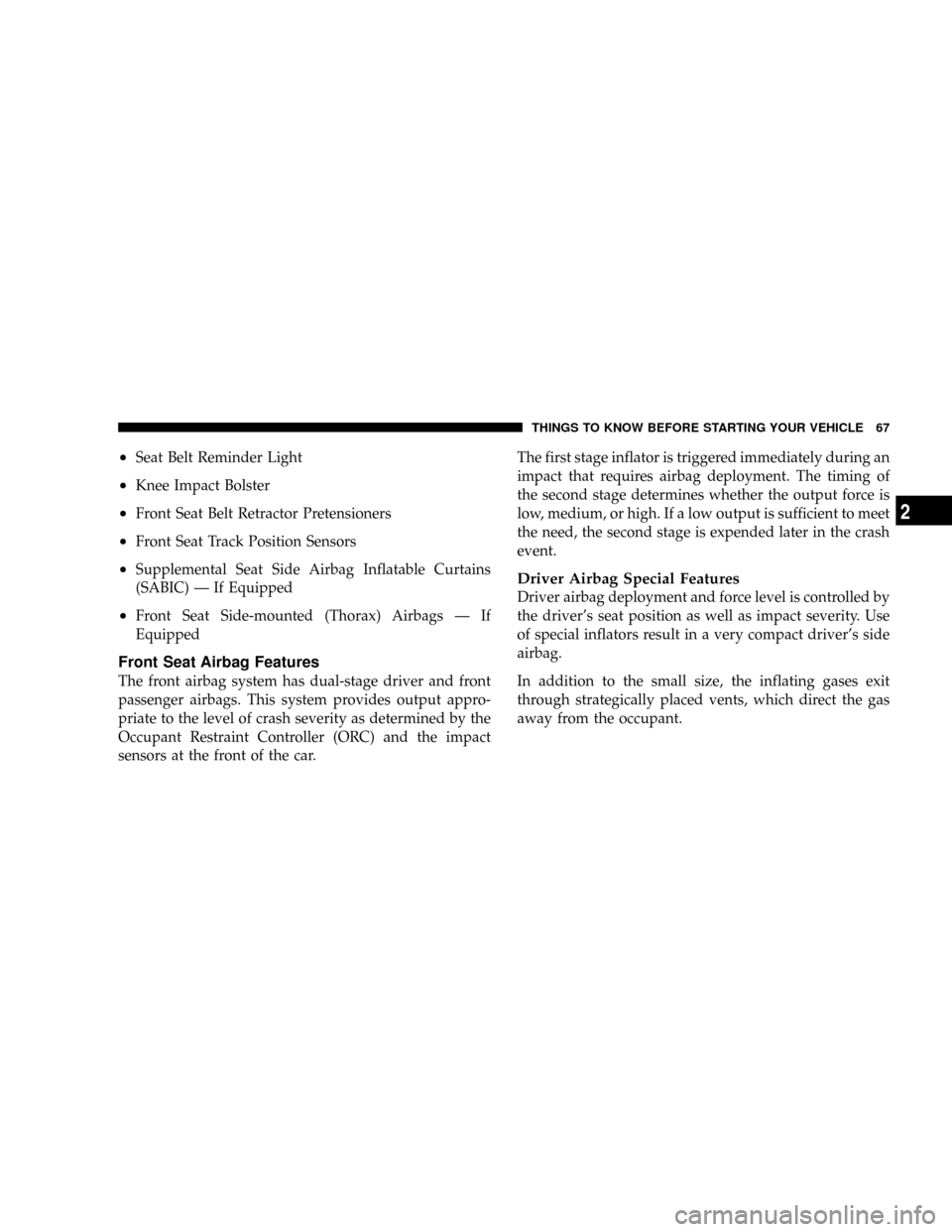
²Seat Belt Reminder Light
²Knee Impact Bolster
²Front Seat Belt Retractor Pretensioners
²Front Seat Track Position Sensors
²Supplemental Seat Side Airbag Inflatable Curtains
(SABIC) Ð If Equipped
²Front Seat Side-mounted (Thorax) Airbags Ð If
Equipped
Front Seat Airbag Features
The front airbag system has dual-stage driver and front
passenger airbags. This system provides output appro-
priate to the level of crash severity as determined by the
Occupant Restraint Controller (ORC) and the impact
sensors at the front of the car.The first stage inflator is triggered immediately during an
impact that requires airbag deployment. The timing of
the second stage determines whether the output force is
low, medium, or high. If a low output is sufficient to meet
the need, the second stage is expended later in the crash
event.
Driver Airbag Special Features
Driver airbag deployment and force level is controlled by
the driver's seat position as well as impact severity. Use
of special inflators result in a very compact driver's side
airbag.
In addition to the small size, the inflating gases exit
through strategically placed vents, which direct the gas
away from the occupant.
THINGS TO KNOW BEFORE STARTING YOUR VEHICLE 67
2
Page 74 of 531
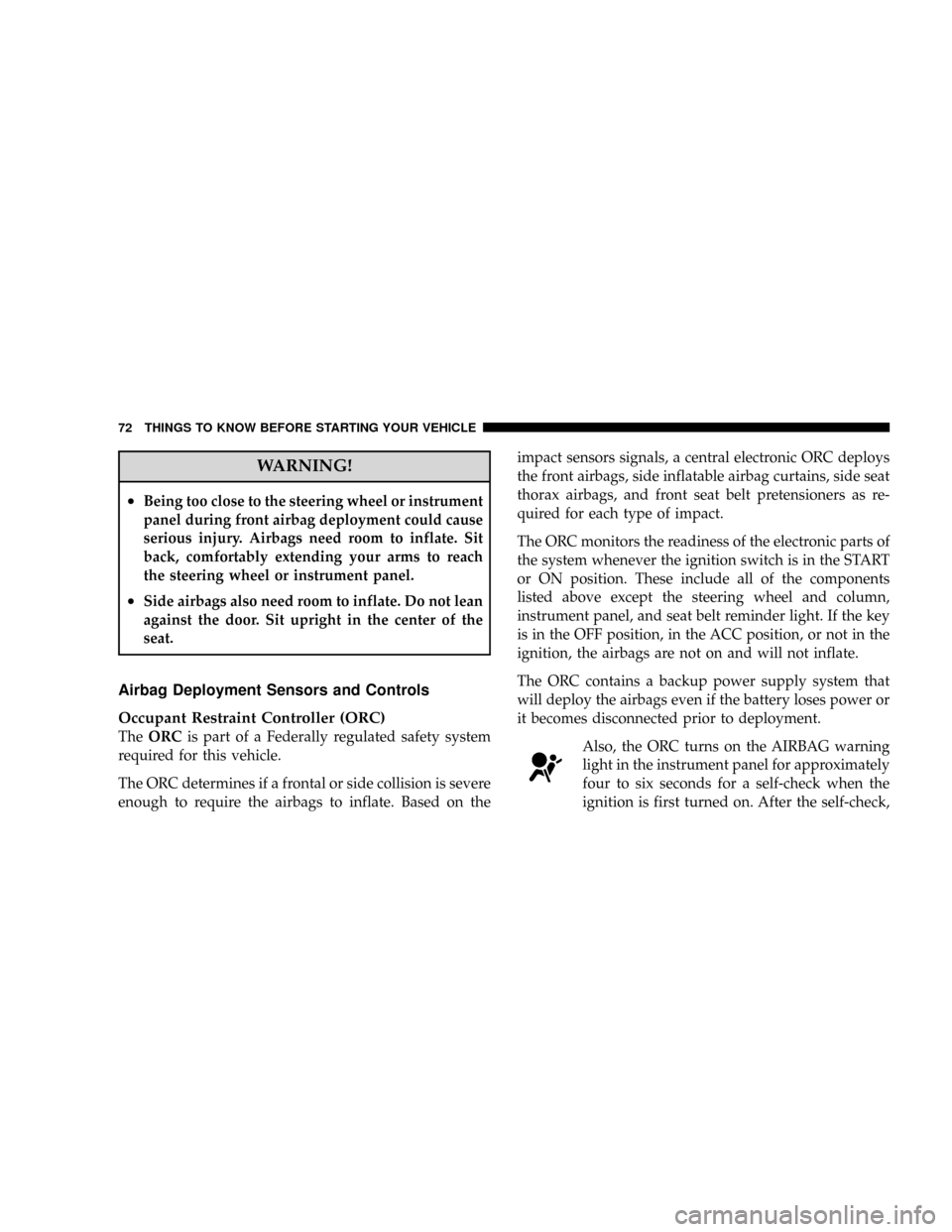
WARNING!
²Being too close to the steering wheel or instrument
panel during front airbag deployment could cause
serious injury. Airbags need room to inflate. Sit
back, comfortably extending your arms to reach
the steering wheel or instrument panel.
²Side airbags also need room to inflate. Do not lean
against the door. Sit upright in the center of the
seat.
Airbag Deployment Sensors and Controls
Occupant Restraint Controller (ORC)
TheORCis part of a Federally regulated safety system
required for this vehicle.
The ORC determines if a frontal or side collision is severe
enough to require the airbags to inflate. Based on theimpact sensors signals, a central electronic ORC deploys
the front airbags, side inflatable airbag curtains, side seat
thorax airbags, and front seat belt pretensioners as re-
quired for each type of impact.
The ORC monitors the readiness of the electronic parts of
the system whenever the ignition switch is in the START
or ON position. These include all of the components
listed above except the steering wheel and column,
instrument panel, and seat belt reminder light. If the key
is in the OFF position, in the ACC position, or not in the
ignition, the airbags are not on and will not inflate.
The ORC contains a backup power supply system that
will deploy the airbags even if the battery loses power or
it becomes disconnected prior to deployment.
Also, the ORC turns on the AIRBAG warning
light in the instrument panel for approximately
four to six seconds for a self-check when the
ignition is first turned on. After the self-check,
72 THINGS TO KNOW BEFORE STARTING YOUR VEHICLE
Page 75 of 531
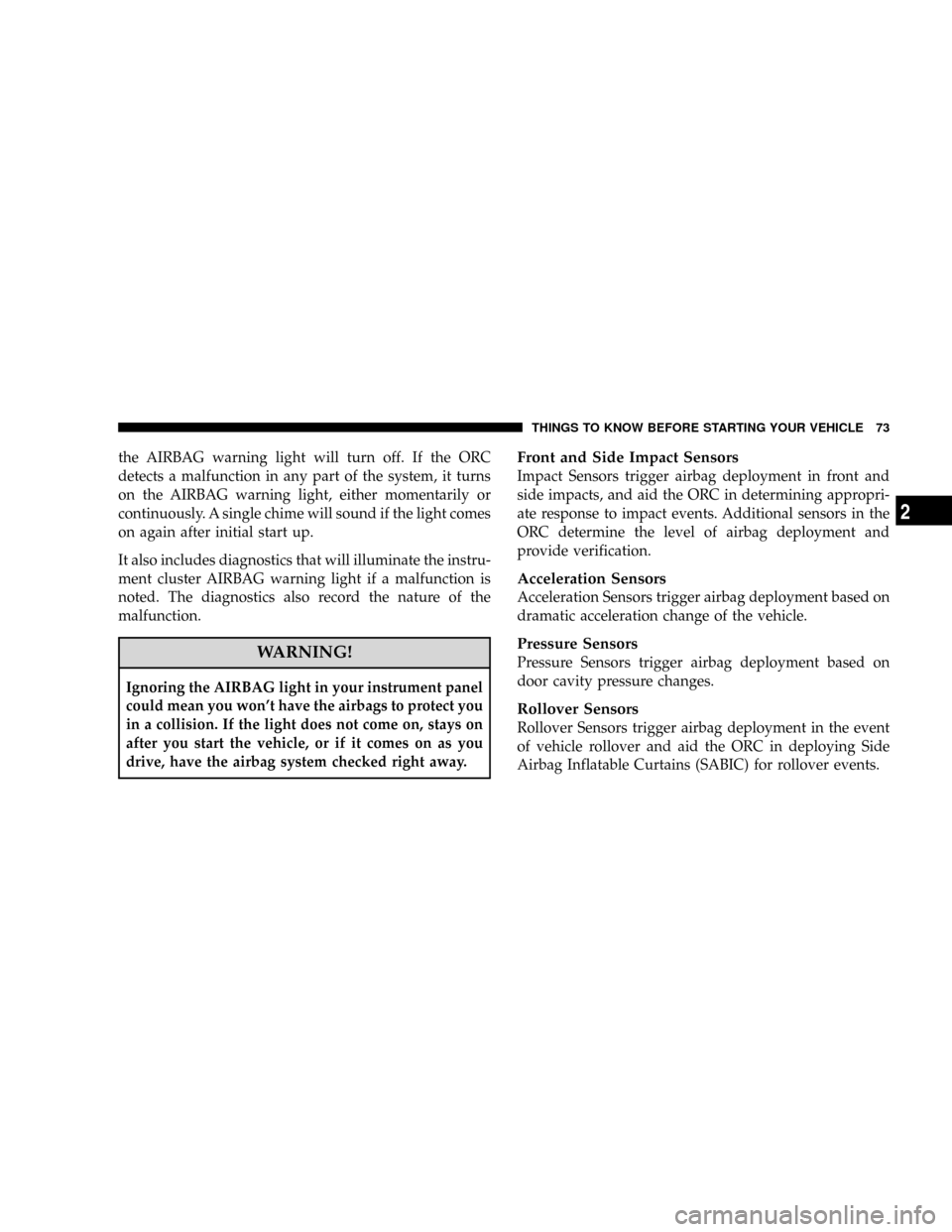
the AIRBAG warning light will turn off. If the ORC
detects a malfunction in any part of the system, it turns
on the AIRBAG warning light, either momentarily or
continuously. A single chime will sound if the light comes
on again after initial start up.
It also includes diagnostics that will illuminate the instru-
ment cluster AIRBAG warning light if a malfunction is
noted. The diagnostics also record the nature of the
malfunction.
WARNING!
Ignoring the AIRBAG light in your instrument panel
could mean you won't have the airbags to protect you
in a collision. If the light does not come on, stays on
after you start the vehicle, or if it comes on as you
drive, have the airbag system checked right away.
Front and Side Impact Sensors
Impact Sensors trigger airbag deployment in front and
side impacts, and aid the ORC in determining appropri-
ate response to impact events. Additional sensors in the
ORC determine the level of airbag deployment and
provide verification.
Acceleration Sensors
Acceleration Sensors trigger airbag deployment based on
dramatic acceleration change of the vehicle.
Pressure Sensors
Pressure Sensors trigger airbag deployment based on
door cavity pressure changes.
Rollover Sensors
Rollover Sensors trigger airbag deployment in the event
of vehicle rollover and aid the ORC in deploying Side
Airbag Inflatable Curtains (SABIC) for rollover events.
THINGS TO KNOW BEFORE STARTING YOUR VEHICLE 73
2
Page 76 of 531

Supplemental Side Airbag Inflatable Curtain
(SABIC) Ð If Equipped
The ORC deploys the SABIC during collision with other
vehicles and during collisions where the impact is con-
fined to a particular area of the vehicle Ð such as
collisions with poles, trees or similar objects.
It will deploy the SABIC only on the impact side of the
vehicle.
NOTE:The ORC does detect and protect for rollover
when equipped with SABIC airbags.
Enhanced Accident Response System
In the event of an impact causing airbag deployment, and
the vehicle communication network intact, and the
power intact, the Enhanced Accident Response System
performs the following functions:
²Cuts off fuel to the engine.
²Flashes hazard lights.
²Turns on the interior lights, which remain on as long as
the battery has power or until the ignition key is
removed.
²Unlocks the doors automatically.
If A Deployment Occurs
The airbag systems are designed to deploy when the
Occupant Restraint Controller (ORC) detect a moderate-
to-severe collision, to help restrain the driver, front
passenger and rear passengers, and then immediately
deflate.
NOTE:A frontal collision that is not severe enough to
need airbag protection will not activate the system. This
does not mean something is wrong with the airbag
system.
74 THINGS TO KNOW BEFORE STARTING YOUR VEHICLE
Page 79 of 531
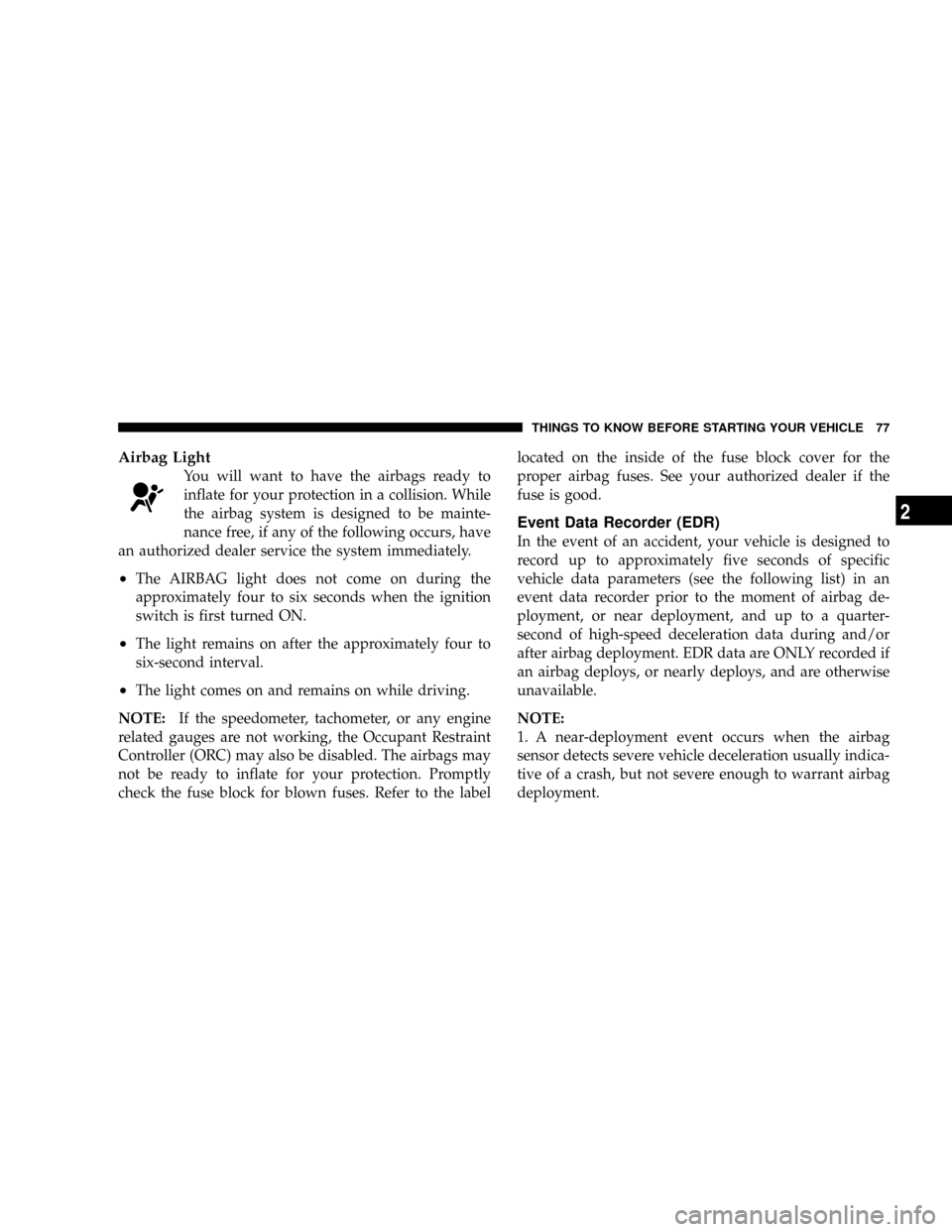
Airbag Light
You will want to have the airbags ready to
inflate for your protection in a collision. While
the airbag system is designed to be mainte-
nance free, if any of the following occurs, have
an authorized dealer service the system immediately.
²The AIRBAG light does not come on during the
approximately four to six seconds when the ignition
switch is first turned ON.
²The light remains on after the approximately four to
six-second interval.
²The light comes on and remains on while driving.
NOTE:If the speedometer, tachometer, or any engine
related gauges are not working, the Occupant Restraint
Controller (ORC) may also be disabled. The airbags may
not be ready to inflate for your protection. Promptly
check the fuse block for blown fuses. Refer to the labellocated on the inside of the fuse block cover for the
proper airbag fuses. See your authorized dealer if the
fuse is good.
Event Data Recorder (EDR)
In the event of an accident, your vehicle is designed to
record up to approximately five seconds of specific
vehicle data parameters (see the following list) in an
event data recorder prior to the moment of airbag de-
ployment, or near deployment, and up to a quarter-
second of high-speed deceleration data during and/or
after airbag deployment. EDR data are ONLY recorded if
an airbag deploys, or nearly deploys, and are otherwise
unavailable.
NOTE:
1. A near-deployment event occurs when the airbag
sensor detects severe vehicle deceleration usually indica-
tive of a crash, but not severe enough to warrant airbag
deployment.
THINGS TO KNOW BEFORE STARTING YOUR VEHICLE 77
2